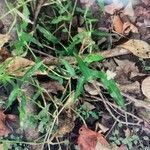Herbs, annual, with long-trailing, decumbent shoots. Leaves: blade linear-oblong to linear-lanceolate, 1.5--7 ´ 0.2--1 cm, glabrous. Inflorescences terminal and in distal leaf axils; cymes 1-several, 1-flowered, solitary or fascicled. Flowers bisexual, radially symmetric, 1 cm wide; sepals 5--6 mm; petals purplish lilac or purple to pink or white, 5--8 mm; stamens 3; filaments bearded; staminodes 3. Capsules (4--)5--9 mm. Seeds 2--6 per locule, 1.6--3 mm, faintly ribbed.
Stems weak, decumbent or prostrate at base, 3–8 dm; lvs lance-linear, 3–6 cm; fls solitary, the pedicels arising from one to several of the upper sheaths, or some of them in 2–4-fld axillary racemes; sep 5–6 mm; pet pink, ca 8 mm. Fresh tidal marshes and margins of lakes and ponds; native to e. Asia, intr. from Md. to Fla., and inland to Ky., Tenn., and Ark. Late summer and fall. (Aneilema k.)
An annual herb. It forms roots at the nodes. It can keep growing from year to year. The leaves are sword shaped and 4-8 cm long by 5-10 mm wide. The flowers are blue-pink. They occur as 1-3 in groups in the axils of leaves. The fruit is a capsule 10 mm long.

